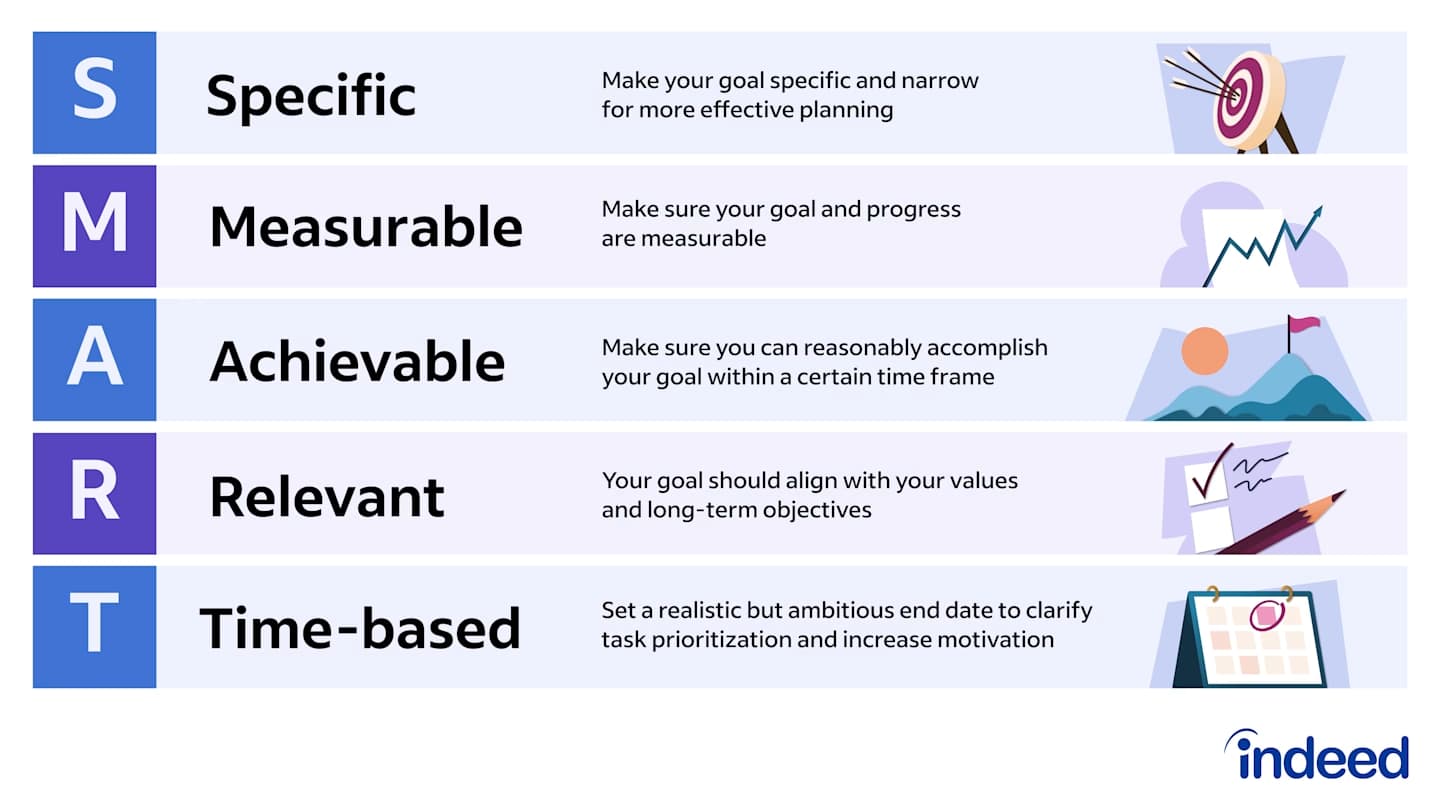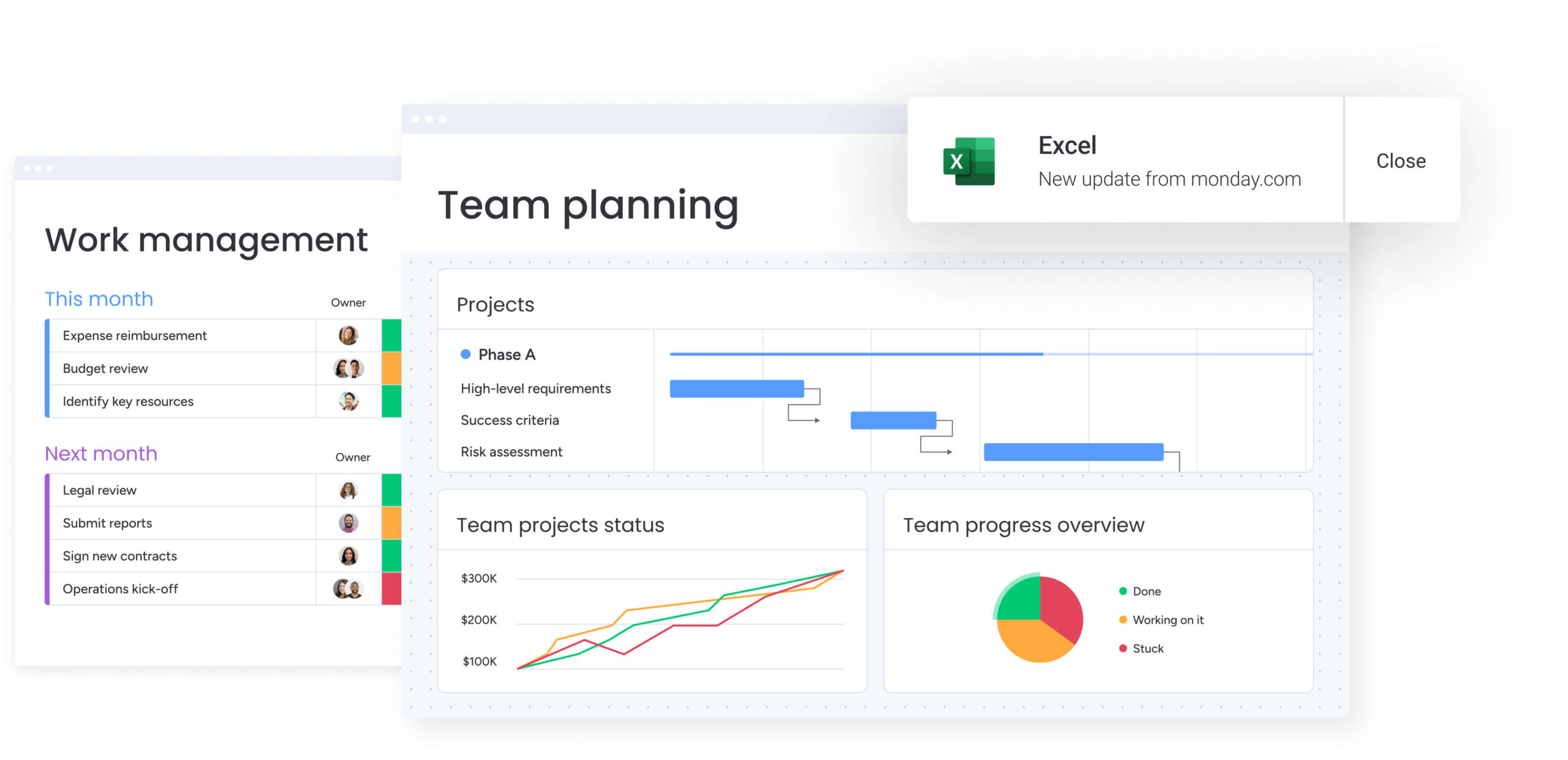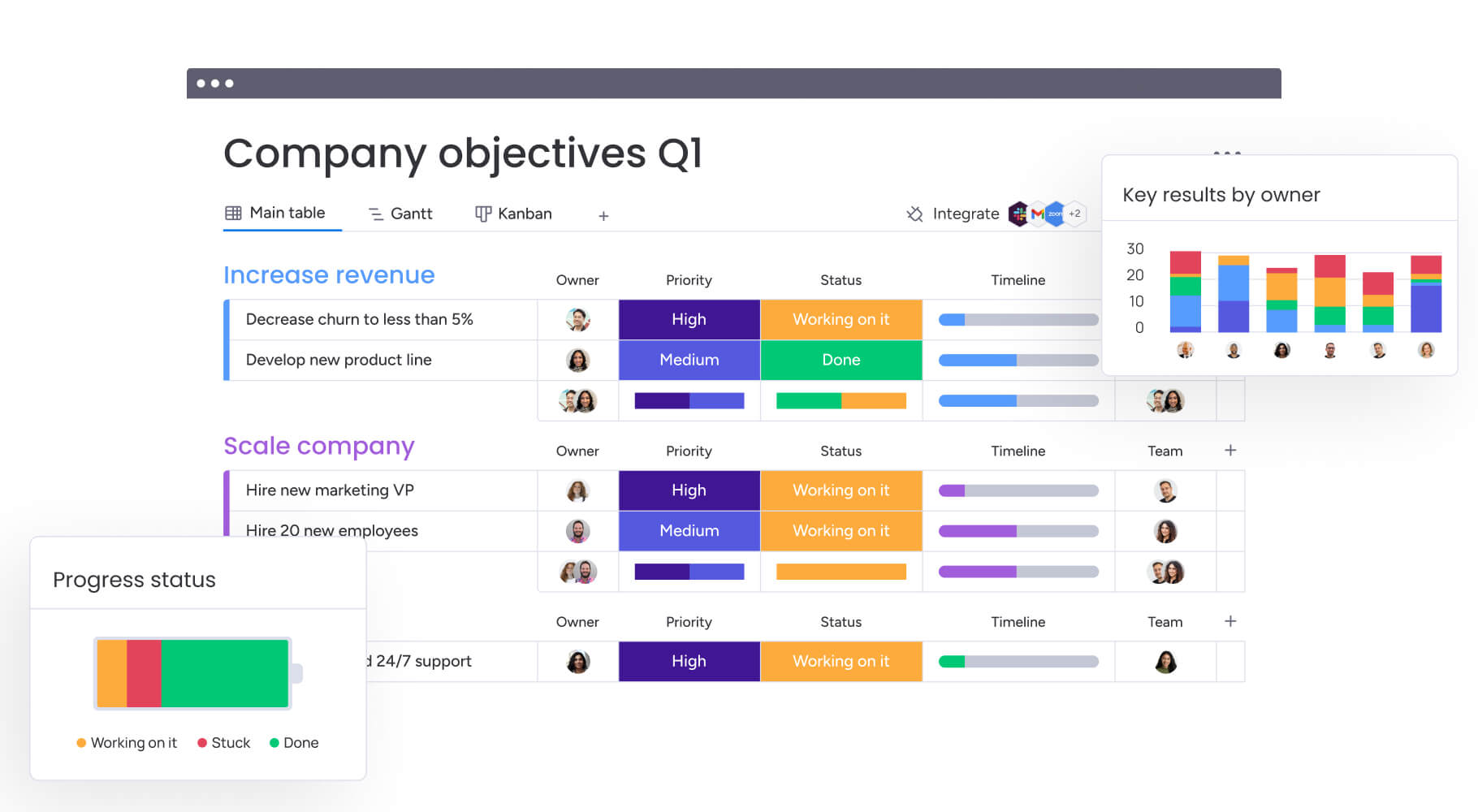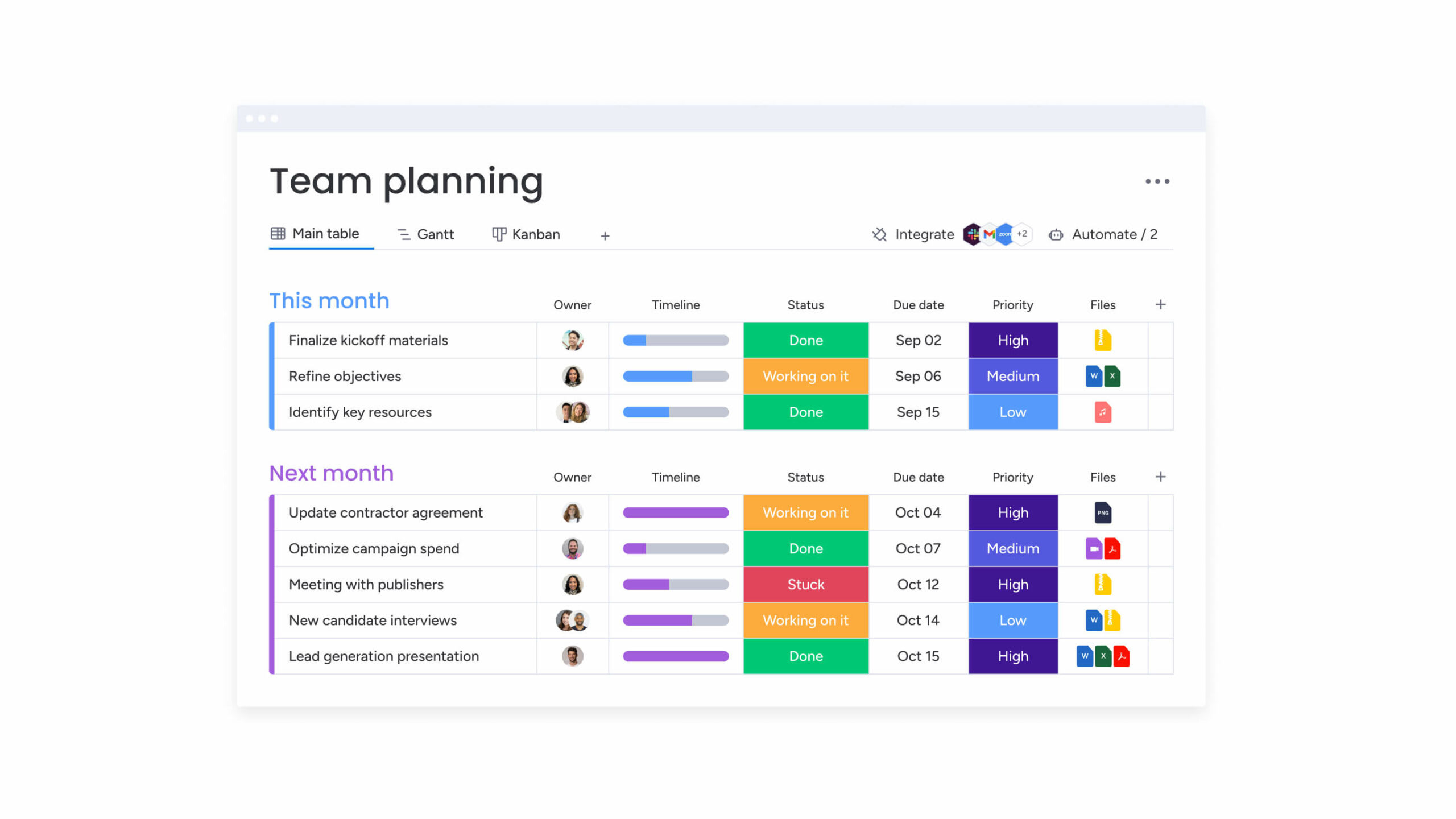Organizations pour resources into defining their goals — the broad directions guiding long-term decisions. But to achieve those goals, your teams need clear, measurable objectives. Objectives break down high-level ambitions into specific, quantifiable, and time-bound actions, so progress can be tracked and achieved.
Good goal management connects your organization’s strategic vision with actionable objectives and daily tasks, keeping your workforce productive and aligned.
Are your teams clear about their business objectives today? Does your strategy translate smoothly from senior leadership down to frontline employees? This article explains why many organizations struggle to manage goals, outlines proven frameworks for setting and achieving objectives, and shows how monday work management can help your organization reach and surpass your goals in 2025.
What is goal management — and why is it essential?
Effective goal management creates clarity by translating strategic ambitions into actionable objectives. First, let’s clearly define the key terms involved:
- Goals are broad, long-term outcomes that define your organization’s strategic direction. They answer, “What do we ultimately want to achieve?”
- Objectives are specific, measurable actions your teams take to achieve those goals. They outline exactly what needs to be done, how it will be measured, and when it should be completed.
- Daily tasks are routine activities that employees perform to fulfill these objectives, steadily driving progress toward your broader organizational goals.
Strong goal management helps you:
- Align individual and team objectives directly with broader organizational goals, ensuring every daily task supports your big-picture vision.
- Clarify roles and responsibilities, boosting motivation and reducing confusion.
- Track progress clearly, helping managers make informed decisions quickly.
- Bridge strategic goals and day-to-day tasks with structured, measurable objectives.
- Improve productivity by focusing your teams on the actions that truly matter.
By following a clear goal management plan, your workforce consistently delivers against strategic priorities — driving higher productivity, motivation, and measurable results. Understanding the distinct types of goals and how they fit into your broader strategy is crucial for successful implementation.
Want to learn more about an effective goal-setting process? Read the complete guide to setting goals at work.
The 3 types of goals managers need to master
To turn big ideas into action, enterprises often break categorized goals to help teams stay focused on moving from planning to execution. Here are three of the most common categories businesses use to set goals:
1. Strategic goals
Strategic goals reflect your company’s long-term vision. These goals set your overall direction and define high-level organizational priorities. For example:
- Expanding into 5 international markets by 2030
- Achieving net-zero carbon emissions within 10 years
- Leading the HR industry in innovation by 2035
- Meeting regulatory requirements across all operating regions within 5 years
Clearly defined strategic goals ensure every employee understands your company’s long-term plans so they can align their efforts accordingly.
2. Tactical goals
Tactical goals are narrower in scope than strategic goals. They include concrete, medium-term objectives that your teams can tackle within months or quarters, and bridge the gap between long-term vision and daily operations. Here are a few examples:
- Launching a new customer loyalty program within 6 months
- Improving customer satisfaction scores by 10% by Q4
- Reducing supply-chain costs by 15% over the next year
- Enhancing product quality through quarterly improvements
Transparent tactical goals help your teams prioritize effectively, allocate resources efficiently, and steadily progress toward broader strategic targets.
3. Operational goals
Operational goals are short-term, actionable targets your teams can complete weekly or monthly. They maintain daily efficiency and productivity, ensuring smooth business operations. For example:
- Achieving weekly sales quotas
- Lowering customer response times from 12 hours to 4 hours by the end of the month
- Increase website conversion rates by 5% within the next 4 weeks
- Completing accurate monthly financial reporting on schedule
Well-defined operational goals keep your employees accountable, engaged, and focused on maintaining consistent performance that supports both tactical and strategic goals.
Why do companies struggle with goal management?
Organizations frequently face obstacles like unclear roles, poor visibility, and disconnected tools. Understanding these challenges helps you address them proactively and keep your teams moving forward.
Poorly defined roles and priorities
When employees lack clarity about their responsibilities, they struggle to prioritize effectively. According to the 2025 world of work report from monday.com, only 43% of employees in large enterprises clearly understand how success is measured. This uncertainty makes it hard for teams to collaborate, causing confusion and reducing motivation. Defining roles and priorities can help boost engagement and ensure your teams know exactly where to direct their efforts.
Limited visibility and ineffective tracking
Even when using work management tools, many enterprise employees struggle to effectively track progress toward their goals. Straightforward, centralized dashboards help leaders and teams spot obstacles early, adjust plans quickly, and maintain confidence in their decisions.
Disconnected tools and inefficient work
Separate tools create communication gaps and duplicate efforts, slowing your teams down. Bringing tools together into a unified platform improves coordination, reduces wasted resources, and keeps your teams productive.
Addressing these challenges helps your organization:
- Connect employee efforts to company priorities
- Define roles and increase motivation
- Adapt quickly with ongoing monitoring
- Deliver measurable outcomes efficiently
So how do you overcome these obstacles? Let’s explore how to choose the right goal management framework.
Which goal management frameworks are most effective for businesses?
Using effective goal-setting methods helps your organization move from broad ideas to measurable results. Each framework offers distinct advantages depending on your organization’s needs and culture.
| Framework | Best for | Example |
|---|---|---|
| SMART goals | Individual, departmental, or company-wide initiatives | Boost customer retention by 10% in 12 months via improved onboarding |
| OKRs (objectives and key results) | Company-wide alignment, team accountability | Objective: Raise customer satisfaction. Key result: Increase NPS by 15% |
| Management by objectives (MBO) | Tracking performance, regular progress checks | Quarterly reviews aligning departmental activities with profitability |
| Agile goal management | Rapid adjustments to feedback or market shifts | Adjust product roadmap each sprint based on user feedback |
SMART goals
SMART goals help you convert abstract ideas into clear, actionable targets. Although commonly used for individual performance tracking, SMART goals are equally effective for departmental objectives, larger business initiatives, and strategic planning — as long as the goals are specific, measurable, achievable, relevant, and time-bound.
Your goals should be:
- Specific: Clearly describe what you’ll do and how you’ll do it
- Measurable: Have defined metrics to assess progress
- Achievable: Possible given your resources and current situation
- Relevant: Connected directly to broader organizational objectives
- Time-bound: Set within a clear deadline

Examples of effective SMART goals for enterprises:
- Increase customer retention rates by 10% within 12 months by enhancing the onboarding experience and launching a loyalty rewards program.
- Reduce departmental expenses by 15% within one fiscal year by consolidating software tools and streamlining internal processes.
- Boost employee satisfaction scores by 20% in the next six months by implementing monthly check-ins, regular recognition events, and providing professional development resources.
OKRs (objectives and key results)
Objectives and key results (OKRs) are ideal for aligning company-wide ambitions with specific, measurable actions at the team level. Unlike SMART goals, which are suited for clearly defined initiatives, OKRs work best when your organization requires coordination across multiple departments.
The OKR framework separates high-level objectives (ambitious goals tied to broader business outcomes) from measurable key results (specific metrics used to track progress). Leaders typically define organizational objectives first, and teams then set their own key results to contribute toward these objectives.
For example, if your organizational objective is to improve customer satisfaction, your key results might include:
- Reduce customer support response times by 20%
- Increase customer satisfaction survey scores by 15%
- Resolve 90% of support interactions on first contact
OKRs provide a structured approach that connects strategic ambitions directly to day-to-day work, supporting cross-functional coordination and stronger organizational alignment.
Management by objectives (MBO)
Management by objectives (MBO) stands apart through its focus on manager-employee partnership and personal development. Unlike other frameworks, MBO explicitly connects a worker’s performance to their goal achievement.
Managers and employees establish measurable targets together and stay coordinated through formal evaluation cycles. Regular check-ins confirm progress and enable stakeholders to adjust course when needed. Here are a few examples:
- Managers and employees meeting every 3 months to assess progress
- Employees earning incentives based on hitting specific revenue, productivity, or customer satisfaction targets
- Managers and employees setting personal and professional growth objectives
The strength of MBO lies in its emphasis on accountability and continuous improvement, making it a powerful framework for organizations that value structured goal-setting and employee development.
Agile goal management
Unlike more rigid frameworks, Agile goal management prioritizes adaptability over fixed targets. This approach uniquely embraces change rather than trying to minimize it.
Your teams examine goals frequently, making adjustments as needed in response to new information. This makes Agile particularly valuable for fast-moving industries or uncertain market conditions.
Examples of Agile goal management in action:
- A sales team adjusting quarterly revenue goals mid-cycle based on evolving customer demand and market conditions
- A tech team refining feature roadmaps based on real-time user feedback rather than sticking to a fixed release plan
- A marketing team revising campaign goals based on performance data, ensuring resources are focused on high-impact initiatives
Want to learn more? Read all about Agile project management.
What are the best practices for goal management in 2025?
To successfully manage goals in 2025, you’ll want to follow these straightforward tips to keep your organization productive, confident about responsibilities, and prepared for changes.
Set clear, actionable goals
Define each goal simply and directly. Using trusted frameworks like SMART goals helps everyone grasp what’s expected and why it matters, which can boost motivation and job satisfaction. You’ll find teams naturally align when goals make immediate sense.
Break down and prioritize goals
Complex goals become more manageable when you divide them into smaller tasks. Organize these tasks by importance, set realistic deadlines, and distribute resources thoughtfully. You’ll prevent burnout and keep efforts focused on what truly matters.
Assign ownership and accountability
Designate specific owners for every goal. Transparent ownership minimizes confusion, prevents overlap between teams, and helps everyone maintain productivity. When people know who’s responsible for what, you’ll see progress happen more smoothly.
Use centralized tracking for better visibility
Consolidate goal tracking with goal management software that everyone uses consistently. This makes spotting issues easier and helps your organization grow without confusion. You’ll notice improved productivity and confidence throughout your business with transparent progress monitoring.
Want to make goal tracking easier? Get our free goal tracker template.
Regularly assess and adjust to maintain flexibility
Check in consistently to ensure your goals remain relevant. Frequent evaluations help you quickly adapt to market changes or internal shifts. You’ll keep your business competitive and focused on meaningful outcomes by staying flexible.
Work smarter by implementing a goal management platform
When employees understand exactly how their daily work ties into the bigger picture, motivation and productivity naturally follow. But as we mentioned earlier, only 43% of employees at large enterprises clearly understand how success is measured — meaning most teams aren’t sure if their work is hitting the mark.
A goal management platform solves this by making goals easy to set, track, and achieve. Employees can clearly see how their individual goals support larger company objectives. When people know their contributions matter, they’re more than twice as likely to feel motivated to succeed. With intuitive goal management software, your organization can drive real engagement, improve performance, and consistently turn big ambitions into tangible outcomes.
What are common pitfalls when implementing a goal management platform?
When introducing new goal management methods or software, keep an eye out for these common issues:
- Overcomplicating goal structures: Too many or overly complex goals cause confusion. Keep goals simple, focused, and clearly tied to organizational objectives.
- Unclear benefits causing low adoption: If employees don’t clearly understand how a new platform will help them, they’ll resist using it. Show specific, practical benefits upfront.
- Insufficient training: Rushed or inadequate training can quickly lead to frustration. Provide accessible, role-specific training sessions so everyone feels comfortable.
- Inconsistent communication: Without regular check-ins, it’s easy to lose momentum. Frequent follow-ups help teams stay on track and adapt as needed.
Recognizing these pitfalls upfront helps ensure your new approach to goal management gets off to a smooth start. But beyond just avoiding mistakes, you’ll need a clear strategy for guiding your organization through this change.
How do you manage change when implementing a new goal system?
Rolling out a new goal management system requires thoughtful change management. Follow these key principles to support your team through the transition:
- Build awareness and understanding: Clearly explain why the change matters. Highlight specific pain points and benefits. For example, “We currently spend four hours each week in status meetings. This new system cuts that down to one, giving us more time for meaningful work.”
- Create a coalition of champions: Identify influential employees who can promote the new approach and help peers get comfortable. Choose respected individuals across various teams who are open-minded and enthusiastic.
- Provide tailored, practical training: Offer specific training tailored for each role. Leaders might focus on strategic value and reporting, while employees need to see how the platform fits their daily work. Use relatable, real-world examples from within your organization.
- Implement gradually: Begin with a pilot group or a specific department rather than an immediate company-wide rollout. This approach lets you address issues early, collect success stories, and refine the approach before scaling up.
- Actively gather and respond to feedback: Use surveys, office hours, or dedicated support contacts to collect feedback. Show your team you’re listening by directly addressing their suggestions.
- Celebrate early successes: Share stories of teams successfully reaching meaningful goals with the new system. Recognize early adopters to encourage wider acceptance and enthusiasm.
With these principles guiding your approach, let’s see how monday work management helps your organization achieve goals more effectively.
How monday work management transforms goal execution

Achieving goals requires simple frameworks, ownership, and visibility. With monday work management, your organization gains a central hub that makes setting, tracking, and reaching objectives straightforward at any scale.
Gain goal clarity and alignment with structured frameworks

Define objectives using intuitive approaches like SMART or OKRs, right within the platform. Implement ready-to-use templates to ensure consistency and help everyone connect their daily work to broader company objectives and goals. Then, create tailored processes and modify them as your business grows — without outside help — so your teams can confidently implement strategy, monitor results, and maintain coordination.
Access real-time tracking with centralized dashboards
See advancement at every level with intuitive goal-tracking views. Monitoring tools give leadership immediate understanding, allowing quick adjustments when initiatives need a course correction. With complete visibility, leaders easily keep everyone informed and moving forward.
Build responsibility with transparent ownership and feedback channels

When every objective and task has a clear owner, teams work more efficiently and avoid unnecessary roadblocks. With built-in responsibility features, monday.com keeps everything transparent, making it easy to track progress, reduce confusion, and foster seamless collaboration across teams.
Plus, adapt quickly to market shifts or changing priorities through integrated feedback channels. Regular progress updates help your teams adjust their focus, ensuring your organization stays responsive and resilient.
How to get started with goal management
Moving from planning to action is simpler than you might think. Start by assessing your current approach and selecting a framework that aligns with your business needs. Choose a specific area or team to pilot your new approach before expanding more broadly.
Remember that the most effective goal system is one people actually use. You’ll want to build regular check-ins into existing meetings, make goal progress visible to everyone, and celebrate early wins to build momentum across your organization.
Help teams understand how their daily tasks contribute to larger objectives. When people see this connection for themselves, they’re more motivated to track and achieve their goals consistently.
With monday work management as your foundation, implementation becomes simpler and more intuitive. You’ll find the platform’s ready-to-use templates, customizable and automated workflows, and clear visibility tools eliminate the technical barriers that often slow adoption of new goal management systems.
When everyone understands the goals, teams perform better — and your business moves confidently toward success. Start turning your vision into faster outcomes with monday work management today.
FAQs
What does it mean to define a goal in management?
Defining a goal in management is a critical part of the goal management process. It involves identifying specific, measurable, and time-bound targets aligned with broader business goals. Instead of vague aspirations (e.g., “improve customer service”), clearly defined goals feature precise metrics and deadlines (e.g., “reduce customer complaint rates by 15% within 90 days by retraining all customer success agents”).
Proper goal definition clarifies exactly what your team will accomplish, how success will be measured, who is responsible, the completion timeline, and why it’s important. This specificity turns abstract ideas into actionable targets, helping managers make more informed decisions.
How should managers set effective goals?
Effective goal creation starts with open conversations to establish realistic yet challenging goals, instead of just assigning targets. Managers should align team members’ strengths and roles with clear, measurable objectives that support the organization's broader business goals.
Document goals transparently, and schedule regular check-ins to track progress and provide support. Great goal-setting actively involves employees in the goal management process, ensuring goals are both motivating and attainable.
Which comes first: goal setting or planning?
Goal setting usually comes before detailed planning, but in practice, it’s often an iterative part of the broader goal management process. Start with initial goal creation, then develop preliminary plans to test feasibility. Use insights from planning to refine your goals and ensure they're achievable. Approaching goal-setting and planning as continuous, connected steps helps avoid setting unrealistic goals or plans that don't meaningfully support your broader business goals.
How can managers ensure goals remain relevant?
To keep goals relevant, managers should integrate regular reviews into their goal management process and set clear trigger events — like significant market shifts or internal organizational changes — to revisit goals. Using a tiered approach can help, with some goals fixed and others flexible based on circumstances. Clearly distinguish outcome goals (desired results) from process goals (methods) so you can adjust your approach without losing sight of broader objectives. Making goal adaptation routine rather than exceptional help managers maintain goal relevance and consistently drive positive business outcomes.
 Get started
Get started 

